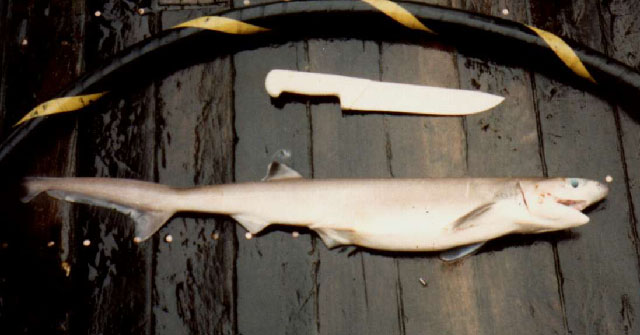| Hexanchidae (Cow sharks) |
| 137 cm TL (male/unsexed); 140 cm TL (female) |
|
bathydemersal; marine; depth range 0 - 1000 m |
| Circumglobal in tropical and temperate seas, excluding the northeast Pacific (Ref. 13573). Western Atlantic: North Carolina, USA and northern Gulf of Mexico to Cuba, then from Venezuela to Argentina (Ref. 6871). Eastern Atlantic: Morocco to Namibia, including the Mediterranean Sea (Ref. 247). Indian Ocean: southwestern India, Aldabra Island, southern Mozambique, and South Africa (Ref. 247). Western Pacific: Japan to China, Indonesia, Australia and New Zealand. Southeast Pacific: off northern Chile (Ref. 247). |
|
Dorsal spines (total): 0-0; Dorsal soft rays (total): 0-0; Anal spines: 0-0; Anal soft rays: 0-0; Vertebrae: 125-161. A narrow-headed, big-eyed small seven-gilled shark (Ref. 247). Body fusiform and slender; dorsal fin small, originating over inner margins of pelvic fins; anal fin small (Ref. 6871). Teeth wide, low and comb-shaped (Ref. 6871). Brownish grey above, paler below, sometimes with indistinct dark blotches on body; juveniles with dark-tipped dorsal and caudal fins, adults with light fin margins (Ref. 5578, 6574, 6871). Live specimens with fluorescent green eyes (Ref. 6871). |
| Found on the outer continental and insular shelves and upper slopes in depths of 100 to 400 (Ref. 13573, 11230), also inshore and down to 1,000 m (Ref. 6871, 11230). Feeds on small sharks and rays, small bony fish, shrimps, crabs, lobsters, squid, and cuttlefish (Ref. 5578). Ovoviviparous (Ref. 205), with 9-12 young born per litter (Ref. 247). Very active and aggressive when captured and quick to bite but too small to be very dangerous to people (Ref. 247). Liver utilized as a source of oil. Maximum length may reach 214 cm, but this is uncertain. |
|
Near Threatened (NT); Date assessed: 21 November 2019 (A2bd) Ref. (130435)
|
| poisonous to eat |
Source and more info: www.fishbase.org. For personal, classroom, and other internal use only. Not for publication.
